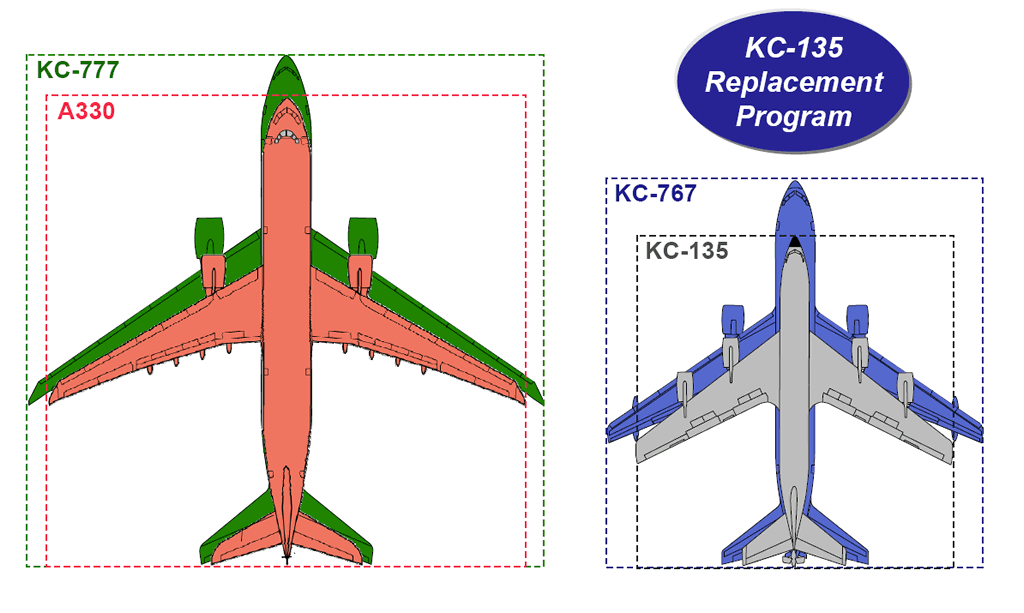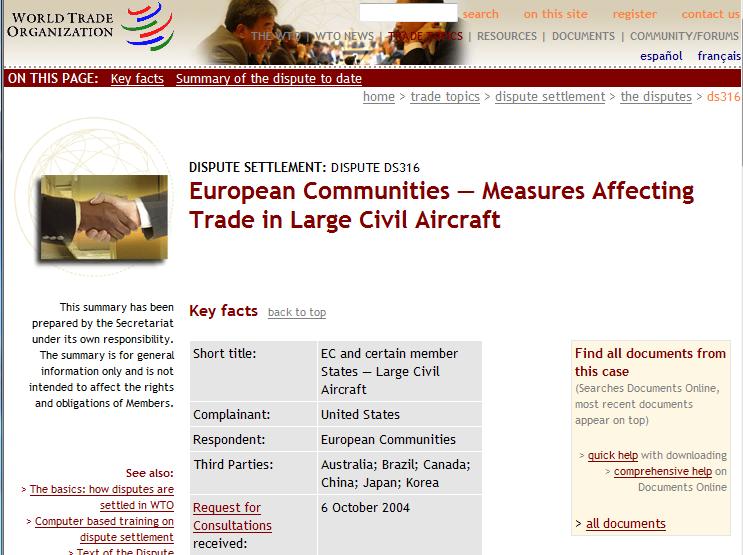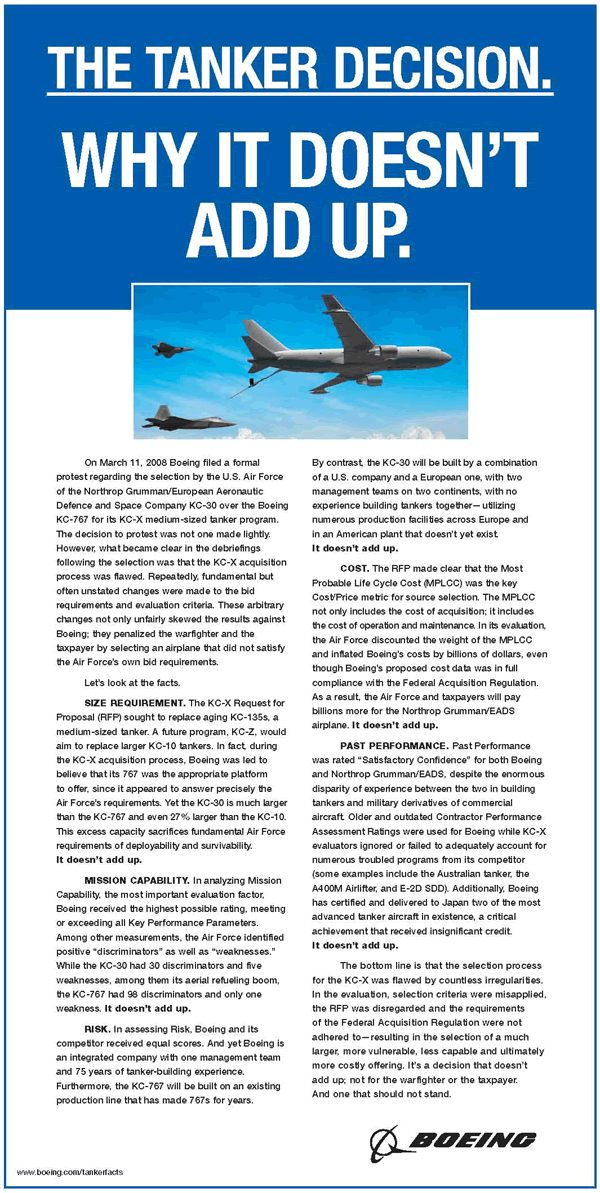|
The
primary mission of the KC-X aircraft will be to provide world-wide,
day/night, adverse weather aerial refueling on the same sortie to
receiver capable United States (US), allied, and coalition military
aircraft (including unoccupied aircraft). The KC-X will provide
robust sustained aerial refueling capability to support global attack,
air-bridge, deployment, sustainment, employment redeployment, homeland
defense, theater support to joint, allied, and coalition air forces,
and specialized national defense missions. The inherent flexibility
of the KC-X platform will accommodate a diversity of secondary missions
in a manner that will not significantly impact the primary aerial
refueling missions. These include airlift, communication gateway,
and aero medical evacuation. The KC-X program acquisition strategy
is focused on an existing commercial, Federal Aviation Administration
(FAA), or equivalent, certified transport aircraft modified to meet
USAF requirements.(1)
Figure
1 - Air force choice option: KC-767 or KC-777

Click to See the link address
Air
force had choice for KC-767 / 777, Did Air force was going to
major the KC-777? This Drawing was showing
that they had option to choose between KC-767 or KC-777
The Infra structure is there Everett, WA + all over the State, and
around the world,
the
Boeing's World Best Technical employers, supporters have designed,
built, tested
and flown and delivered 767s 1000.
Using existing facility will make sense to the Air force and Tax
payers
Suppliers, Partners are ready to Build:
44, 000 + around the
world Suppliers, Partners.
Don't forget The Boeing has the employees 150,000 +
Think KC-X eliminating from the Boeing means
Ripple global recession + USA recession
You won't see the current but see the Future what will happen.
Do not create the current recession + worse
Protect Global balance + current employees where they are now
+ small business around the world
The
Air Force plan to replace its elderly KC-135 tanker fleet comprises
three increments: KC-X, followed by Y and Z, with each representing
about one-third of the overall buy of some 479 aircraft. The service
expects to make a contract award announcement for the KC-X portion,
giving the total contract for 179 tankers to either Boeing or the
Northrop Grumman-EADS team. The entire replacement program would
extend to 2051 at the expected rate of purchase of only up to 18
aircraft per year.
John
A. Tirpak described that the ABCs of Tanker XYZs: The Air Force
does plan to buy replacement tankers in three increments which
will be the KC-X contract award. This will cover the first increment
of 179 tankers, replacing the very oldest KC-135s in the fleet.
Lt. Gen. Donald Hoffman, USAF's military acquisition deputy, explained
the three-stage approach in a closed door briefing before the
House Armed Services AirLand Subcommittee last week. About 2023,
the Air Force plans to contract for a second batch of tankers,
dubbed KC-Y, and in 2033, it goes for the third or KC-Z batch,
ultimately retiring all KC-135s along the way. At no time are
tanker purchases expected to exceed $3 billion a year in current
dollars; that’s all the Air Force expects to be able to spend
(see above). For that money, the service expects to be able to
buy between 12 and 18 per year, replacing the entire tanker fleet
over 40 years.
There has been speculation that a protest by the loser is inevitable
since the stakes in the KC-X program were so high: The winner
may eventually have the inside track on building hundreds of more
tankers to replace some 500 KC-135s in the fleet. “Once we have
reviewed the details behind the award, we will make a decision
concerning our possible options, keeping in mind at all times
the impact to the warfighter and our nation,” Barksdale said.
Hope this reconsider the issues and possible options to take look
carefully. (5)
Figure
2 - Eventually the KC-135s will retire along the way by 3 stages
Replacing
the entire tanker fleet over 40 years

Boeing
has been the main supplier of tankers since World War II. Accordingly,
Boeing and suppliers and partners around the world feel it's their
birthright to provide the next generation of tankers with the 75
years of experienced.
The
Boeing has been built the foundation with the public and suppliers,
partners, officers around the world it is already there to build
every details that you think of it. Trying to make a new resources
to build from someplace is not ready for the emergency cases something
that you have never thought about the 9.11 before year 2001.
|
Security,
safety, all other aspects that the Air force already built
with the Boeing during the 75 years. That is not easy to build
again especially with the conflict of interest unfair EU subsides
for more than 35 years which is the EADS that 46 percent stake
in another top French defense group, Dassault. 5 percent owned
by Russia: in early September, Vneshtorgbank - 99.9 percent
owned by the Russian state - purchased 5.02 percent of EADS
stakes in 2006.
EADS
has in fact a complex management and shareholder architecture.
It is a Franco-German giant with significant Spanish and British
(in Airbus) participation. (9)
The
subsidies in question include those relating to the entire
family of Airbus products (A300 through the A380) (3) .
According
to the request for consultations from the United States, measures
by the EC and the member States provide subsidies that are
inconsistent with their obligations under the SCM Agreement
and GATT 1994. The measures include: the provision of financing
for design and development to Airbus companies (“launch aid”);
the provision of grants and government-provided goods and
services to develop, expand, and upgrade Airbus manufacturing
sites for the development and production of the Airbus A380;
the provision of loans on preferential terms; the assumption
and forgiveness of debt resulting from launch and other large
civil aircraft production and development financing; the provision
of equity infusions and grants; the provision of research
and development loans and grants in support of large civil
aircraft development, directly for the benefit of Airbus,
and any other measures involving a financial contribution
to the Airbus companies. The subsidies in question include
those relating to the entire family of Airbus products (A300
through the A380)(10)
Figure
3 - EC and Certain member States - Large Civil Aircraft

The
issue has acquired new urgency in recent years as Airbus sought
and received substantial new subsidies (so-called "launch
aid") for the Airbus A380 super jumbo aircraft and commitments
of further launch aid subsidies for its new A350 passenger
aircraft. This is well known by the world and the record shows
that when Airbus is delivering more aircraft than its U.S.
rival, the Boeing Company at that time. The United States
believes that there is no justification for continued subsidies
to Airbus.
|
The
Boeing has major played a significant role in our nations security
since 75 years ago and The Boeing's Tanker KC-767 / KC-777 has already
flexibility for the war fighters and fuel tankers it has already
extensive capability than what you can think of it for the global.
It is only you can see from the Boeing Company what other can not
see the details as for the security and safety purpose possessed
multi purpose of war fighter (If
you need more detailed info contact: Boeing Company).
Figure
5 - KC -135 Fuel Tankers usage metrics
| The
Boeing KC135 fleet started since 1950. was able to affectively
using for the Vietnam War during the 1960 and 1970s by flying. |
| Cold
War 1960
and 1970 |
Refuel
acquired B-52 nuclear bombers operated by Strategic air
Command. |
194,687
sorties |
Average
21,00 sorities each year sorties |
Almost
9 billion pounds of jet fuel
|
| 1991
Persian Gulf |
Fuel
Tankers contributed to two objectives |
100
Fuel Tankers |
Tankers
allowed Defense and command and control aircraft to remain
aloft for exdtended periods of time while extending the
range of most attack mission |
306
tankers flew 16,865 missions while delivering over 800
million pounds of fuel to 51,696 receiver aircraft. |
|
NATO COMMBAT |
1999,
5,215 SORTIES (transferring more than 253 million pounds
of fuel to 23,095 coalition receivers) |
9.11,
2001 to 2007 |
F
lew 10,400 missions enabling homeland defense air patrols
|
|
| Homeland
Defense Air Patrols Part of Operational Noble Eagle
|
1999
|
2001
to 2002
|
2003
|
2004
|
2005
|
2006
|
2007
|
| Operations
|
NATO
|
Afghanistan
|
Operation
Iraqi Freedom
|
Operations
Iraqi and Afghanistan |
Operations
Iraqi and Afghanistan |
Operations
Iraqi and Afghanistan |
Operations
Iraqi and Afghanistan |
| TANKERS |
175 |
80
|
185 |
|
|
|
|
| Sorties |
5,215 |
15,468 |
6,193 |
12,465 |
12,391 |
12,787 |
15,875 |
| Fuel
Offloaded (lbs). |
253
million pounds |
1.166
billion (lbs) |
376
million (lbs) |
740
million |
778
million |
871
million |
946
million |
| Receivers
Refueled |
23,095 |
|
28,899 |
|
|
42,083 |
79,798 |
| Aircrafts |
|
50,585 |
|
|
|
|
|
Source:
US Central Air Forces / Combined Air Operations Center
Public Affairs Office
|
|
The
Washington state delegation, International Union's Indorsement,
Officials, Communities are united and stand together (Click to see
the links)
The
Washington state delegation naturally rallied around Boeing. The
company's commercial airplanes are built in the Seattle suburbs
and the KC-767 or KC-777 will be built there. Rep. Norman Dicks
and senior Sen. Patty Murray, both Washington state have been particularly
vocal for Boeing; Murray has made the "illegal" subsidies to Airbus
a signature political issue.
U.S.
Senator Maria Cantwell, stated that The U.S. Air Force has critical
needs we cannot afford to ignore. The Air Force has made clear we
cannot risk systemic failures by not moving ahead with new Boeing
tankers." (6).
RFP also incorporated changes that include addressing the WTO litigation.
(8)
Tanker
Contract Will Help Ensure a Healthy Aerospace Industry:
Senator Patty Murray wants to make sure that the aerospace industry
stays strong and competitive and continues to . The Washington
State is already supporting the 100 percent + around the state
include $150,000 + employees, suppliers and partners around the
world.
February,
17, 2008, Airforcetimes.com: Tuesday Feb 13, 2007, by By John
T. Bennett - Staff writer: The Air Force's requirements for the
new fleet of tankers indicate the service wants a plane that sometimes
can also carry passengers and cargo - or a mix of both. Northrop
officials have said they chose the larger A330 because of a determination
that the service planned to use the KC-Xs as airlifters more often
than its existing tankers.
"The
challenge" for an air planner "is to have enough tankers at the
right place at the right time," said Sams, a retired Air Force
lieutenant general who last commanded the 15th Air Force..
The
Boeing has met more than exceed all the requirements what they
are asking from the Air force requirements the KC-767 and the
KC-777 both has the strategic tanker mission using a fuselage
mounted "flying boom" and multi-point hose/drogue systems. As
a strategic airlifter, the concept can deliver over-sized military
equipment into bare bases while providing performance comparable
to modern commercial airliners. The modular medium transport concept
uses major structural and system components from the KC-767 or
777 reduce life cycle cost. The medium transport is designed to
deliver over-sized military cargo into bare bases while providing
flight performance comparable to commercial transports. The concept
is fully airdrop capable and can operate from short, soft soil
fields at reduced take-off weights.
Back
in 2004, the senate already indicated that KC-767 aircraft to
modernize the Air Force's aerial refueling capability is the deleterious
effect of corrosion on the material condition of the current KC-135
fleet of aerial refueling aircraft.
Section
133 of H.R. 4200 Ronald W. Reagan National Defense Authorization
Act for Fiscal Year 2005 as cleared by the Congress on October
9, 2004 would modify the authority provided in current law which
allows the Air Force to acquire 100 KC-767 tankers through a hybrid
acquisition strategy to "lease" no more than 20 tanker aircraft
and purchase as many as 80 additional aircraft under multiyear
procurement authority.
The
Tanker request purpose was based on the KC-135 modifications.
On 25 April 2006 the Air Force has issued a Request for Information,
or RFI, for its tanker recapitalization program. The Tanker Systems
Modernization Systems Squadron of Aeronautical Systems Center's
Mobility Systems Wing here sent out the RFI for publication in
Federal Business Opportunities and will manage the program. By
issuing the RFI, the Air Force has restarted the requirements
and acquisition processes necessary for a traditional competitive
acquisition program to replace the KC-135 Stratotanker. The RFI
requested information on KC-135 replacement platforms that is
consistent with the findings of the Analysis of Alternatives,
which focuses on a commercial-derivative tanker aircraft in the
300,000- to 1 million-pound-take-off weight class. The RFI asks
for vendor inputs on capabilities to complement the recapitalization
effort, such as specialized commercial aerial refueling services
and KC-135 modifications and upgrades. So the Boeing has been
ready to modification and upgrades.
KC-767
tankers provide increased aircraft availability, more adaptable
technology and greater overall capability than the current inventory
of KC-135E tankers they will replace. Enhancements to every aspect
of aircraft operation will provide the Joint warfighter with more
flexible employment options. KC-767 tankers will be able to ensure
that the viability of this vital national capability. KC-767 makes
the Air Bridge possible and is essential to the success of joint
and coalition military operations. KC-767 Tanker have the capability
of deployment of joint combat power, and are crucial to rapid
response to combat and humanitarian relief operations. You want
the bigger size? The KC-777 will be able to handle bigger cargo,
bigger humanitarian carriers.
Air
Force already indicated that The KC-135E is a good example. It
is significantly less capable than the KC-135R with less fuel
offload capability and fails to meet world-wide airspace and noise
restrictions.
The
Air Force should have majored the fairness, full based on open
competition, defined an integrated, capability, best value approach,
and technologies for the industry best practices which will lead
to the fielding of a flexible and versatile platform without being
surprise the world. If the Air Force wanted a bigger than the
KC-767, The Air Force should have looked at the KC-777 which has
far more capability than the A330 and a bigger and giant also
have more fuel efficiencies, a bigger cargo capabilities than
more you asking for ….. If the Air Force has not seen the KC-777,
the Air Force should revisit the KC-777 Manufacture place in Everett,
Washington how incredible that would bring the war Fighter Fuel
Tanker will be…… This is the fact.
If
the RFP stipulated nine primary key performance parameters as
the following, The Boeing Company has met above 9 categories besides
their 75 years of experience and far more capabilities what Air
Force asking for…
1)
Air refueling capability (same sortie boom and drogue capable)
2) Fuel offload and range at least as great as the KC-135
3) Compliant CNS/ATM equipment
4) Airlift capability
5) Ability to take on fuel while airborne
6) Sufficient force protection measures
7) Ability to network into the information available in the
battle space.
Boeing
is the world's leading aerospace company and the largest manufacturer
of commercial jetliners and military aircraft combined. Additionally,
Boeing designs and manufactures rotorcraft, electronic and defense
systems, missiles, satellites, launch vehicles and advanced information
and communication systems.
Boeing
has customers in more than 90 countries around the world and is
one of the largest U.S. exporters in terms of sales. Boeing employs
more than 160,000 people across the United States and in 70 countries.
The Boeing Company has the most diverse, talented and innovative
workforces anywhere around the world. More than 83,800 of our people
hold college degrees--including nearly 29,000 advanced degrees--in
virtually every business and technical field from approximately
2,800 colleges and universities worldwide. The Boeing Company continues
to plant the seeds which is explains the world best leaning together
program that expend employees knowledge outside of what's available
at Boeing. Under this program, Boeing pays for tuition and many
related expenses - including application fees, entrance exams, books,
and graduate fees - for employees enrolled in accredited colleges,
universities or trade schools. Employees who complete degrees are
eligible for Boeing stock awards.
The
Boeing's enterprise also leverages the talents of hundreds of thousands
more skilled people working for Boeing suppliers worldwide.
Reported
by Catch4all.com, Sandra Englund, March 9, 2008
Sources:
1)
http://www.airforcetimes.com/news/2007/02/AFtankers070212/
2) http://www.globalsecurity.org/military/systems/aircraft/kc-x.htm
3) http://catch4all.com/positive/2008/Boeing/KC-X/WashingtonSenateLetterToUS_Leaders3_4_08.htm
4) http://catch4all.com/positive/2008/Boeing/KC-X/KC-XmakesSenceWithTheBoeing.htm
5) http://catch4all.com/BadDecisionKC45/TheTaxPayersDoNotWantToPayKC45_
TheUS_EconomicISinRECESSION.htm
)ttp://catch4all.com/positive/2008/EUsubsidies/MustStop/EUsubsidies26.htm
7) http://catch4all.com/positive/2006/EUsubsidies11.htm
8)
http://www.heraldnet.com/stories/07/03/29/100bus_tanker001.cfm
9)
International
Relations and Security Network Management Information, Sharing Knowledge
10) WTO
dispute settlement - the diputes DS310.
11) http://www.airforcetimes.com
|























